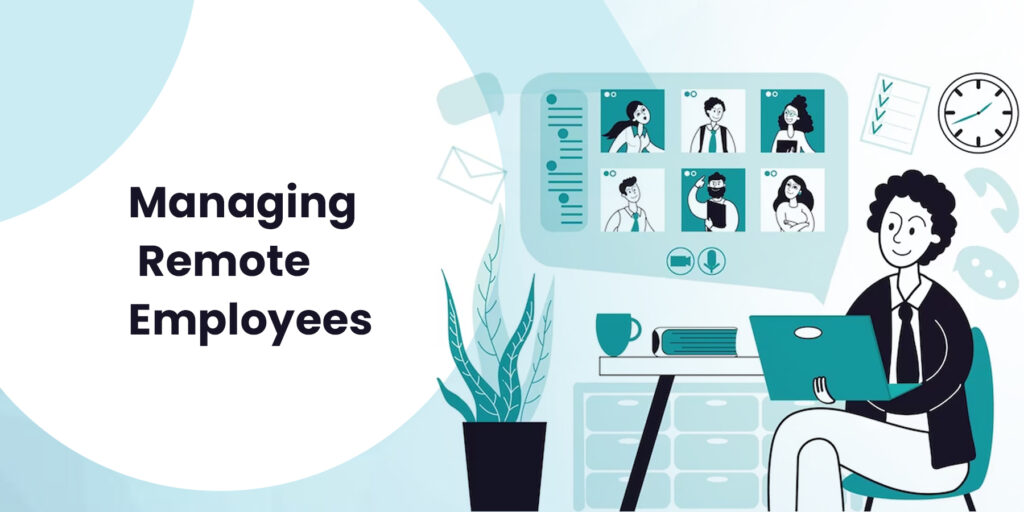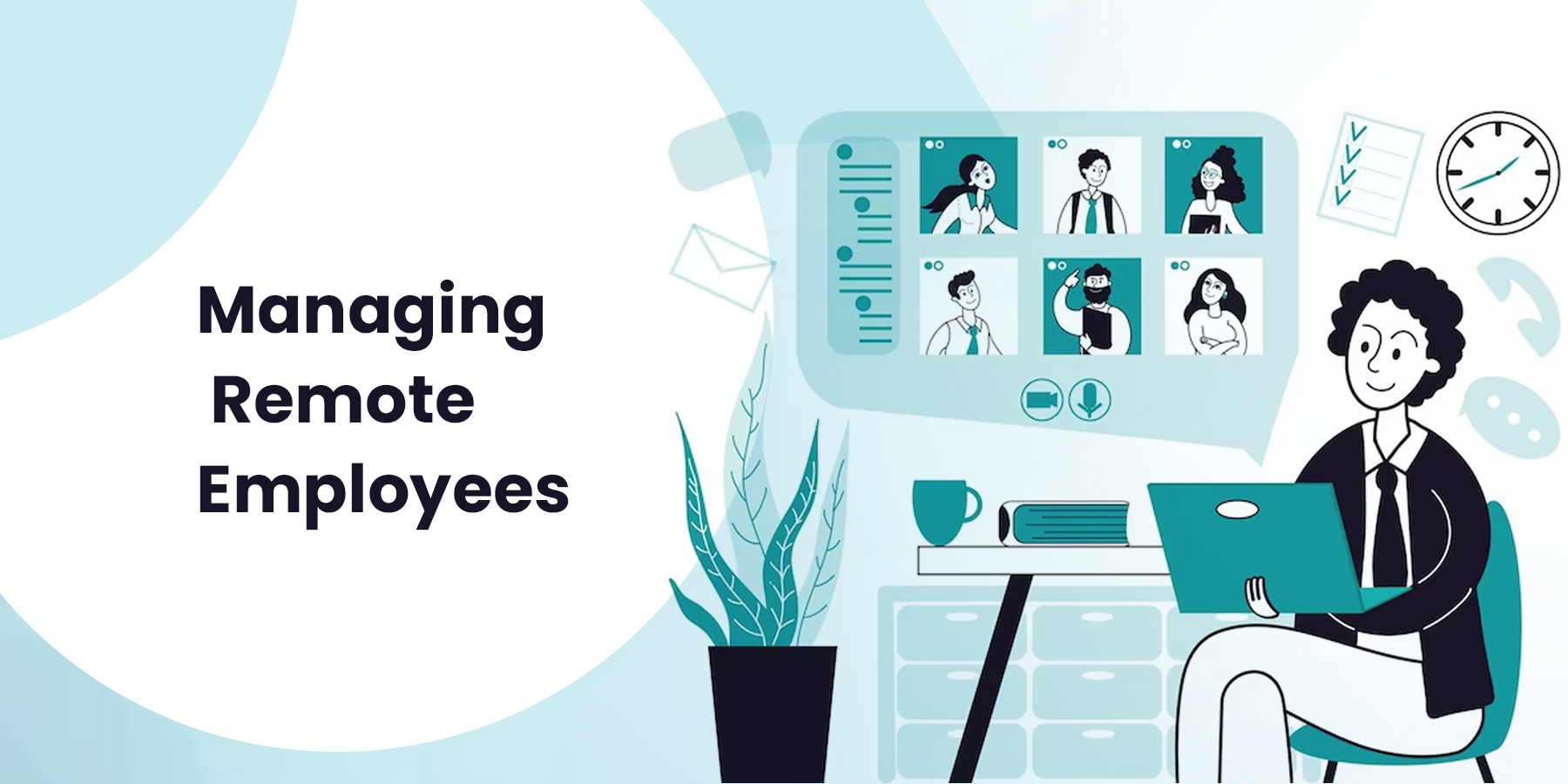
Managing remote employees presents distinct challenges that require specific strategies and approaches. Visibility, connection, communication, and connectivity are the four main challenges of remote work that managers must navigate. Recognizing and addressing these challenges is crucial for managing remote employees. Each challenge presents its own obstacles to overcome to ensure successful remote team collaboration and performance. Practicing practical management approaches and enforcing best practices make managing remote employees the best.
Challenges
1. Visibility:
In a remote work environment, the natural visibility of team members’ activities is diminished. This lack of visibility can lead to challenges in establishing trust, empathy and ensuring individual and team accountability.
Working remotely exposes employees to potential distractions in their home environments. The absence of direct oversight may tempt some individuals to take advantage of the situation. Thus, it becomes essential for managers to implement strategies to maintain productivity and focus.
Managers can implement various practices to improve visibility in a remote setting, such as regular check-ins, transparent communication, and tracking progress through collaborative tools. Building a culture of trust and fostering open communication channels can also address trust issues.
2. Connection
The absence of in-person interactions can hinder the development of strong ties and camaraderie among team members. It can adversely affect team morale and ultimately impact productivity.
When team members feel disconnected or lack a sense of belonging, their confidence can suffer. It, in turn, may lead to decreased motivation, lower productivity levels, and a decline in the quality of work.
Managers can employ strategies to promote connection and promote team energy, such as virtual team-building activities, regular video conference meetings, and creating opportunities for informal interactions. Encouraging open communication and recognizing individual and team achievements can also contribute to a positive team dynamic.
3. Communication
Remote work reduces the natural opportunities for spontaneous and informal communication in physical office spaces. Lack of face-to-face interaction can hinder the exchange of information, collaboration, and effective decision-making.
Effective communication is crucial for successful collaboration within remote teams. Overcoming communication barriers involves selecting appropriate communication tools, setting clear expectations, and establishing regular and transparent information-sharing protocols.
Managers can implement strategies such as promoting active listening, encouraging video conferencing for meaningful discussions, and leveraging collaborative platforms for real-time collaboration. Providing clear guidelines for communication and fostering an environment that promotes open dialogue can enhance overall communication effectiveness.
4. Connectivity
Connectivity issues related to the office or home environment can significantly impact remote team members’ productivity and overall work experience. Slow or unreliable internet connections can lead to frustration, decreased efficiency, and negatively affect team morale.
Having a reliable internet connection is crucial for remote team members to perform their roles effectively and feel supported by the organization. Managers should acknowledge the importance of reliable connectivity in ensuring employee satisfaction, productivity, and well-being.
Connectivity issues can significantly impact remote team members’ productivity and work experience. To address these challenges effectively, managers can collaborate with IT departments, assess infrastructure and resources, explore options for internet access, provide technical support, implement backup plans, facilitate equipment and resources, promote communication and collaboration tools, and regularly monitor and address connectivity issues.
Effective Management Approaches for Managing Remote Employees
1. Setting Clear Objectives And Promoting Team Ownership:
To overcome the challenges of managing remote employees, managers must set clear objectives and empower team members to take ownership of their work. Clearly defined goals and expectations provide direction and focus, enabling remote team members to align their efforts effectively.
Managers can establish a collaborative process for setting objectives, involving team members in defining goals, and giving them the autonomy to determine the best approaches to achieve them. This approach fosters a sense of ownership and responsibility among team members, leading to increased engagement and accountability.
2. Establishing Team Norms In Critical Areas:
To mitigate the challenges of remote work, managers should establish team norms in critical areas that directly impact remote team performance. These norms provide a framework for consistent behavior and expectations across the team. Some of the norms are noted below:
- Internet connection: Managers should encourage team members to maintain reliable internet connections to ensure smooth communication and collaboration. Establishing guidelines for backup plans and contingency measures in case of connectivity issues can help minimize disruptions.
- Home office standards: It is vital to define and communicate benchmarks for remote work environments, including ergonomic considerations, suitable equipment, and appropriate workspace setup. It promotes productivity and supports the well-being of team members.
- Chat and email usage: Guidelines for chat and email usage can streamline communication and prevent information overload. Managers should encourage the use of appropriate channels for different types of communication, establish response time expectations, and promote clarity and conciseness in written exchanges.
- Virtual meeting etiquette: Establishing virtual meeting etiquette ensures remote team members can effectively participate and collaborate in online meetings. It includes guidelines for joining meetings on time, minimizing distractions, actively participating, and using video when appropriate to enhance engagement and connection.
- Regularly revisiting and adjusting team norms to meet evolving needs: Remote work dynamics and the challenges remote teams face can evolve. Therefore, it is essential for managers to regularly revisit and adjust team norms to ensure they remain effective and aligned with the team’s needs.
Promoting Collaboration and Engagement
1. Implementing Daily Stand-Up Meetings
Daily stand-up meetings allow remote team members to share updates, discuss progress, and align their efforts. These brief and focused meetings help foster collaboration, maintain visibility, and address immediate issues or concerns.
2. Organizing Virtual Team Events
Virtual team events, such as team-building activities, online social gatherings, or virtual workshops, create opportunities for remote team members to interact and build stronger connections. These events contribute to team morale, foster a sense of belonging, and enhance overall engagement.
3. Leveraging Appropriate Collaboration Tools
Managers should identify and leverage collaboration tools that facilitate effective remote team collaboration. It may include project management platforms, video conferencing tools, instant messaging apps, and document-sharing platforms. Training and support in using these tools ensure optimal utilization and encourage seamless collaboration among remote team members.
Ongoing Learning and Development
Emphasizing Ongoing Learning And Development
Managing remote employees requires unique skills and approaches. Managers should prioritize continuing learning and development in remote management strategies and techniques. It can be achieved by attending relevant webinars, workshops, or courses, reading industry best practices, and sharing peer-to-peer knowledge.
Creating A Continuous Improvement Culture
Encouraging a constant improvement culture within remote teams involves promoting a growth mindset and providing opportunities for skill enhancement. Managers should support professional development initiatives, encourage knowledge sharing among team members, and create a safe environment for experimentation and learning from failures.
Conclusion
Successfully managing remote employees necessitates understanding and addressing the challenges of visibility, connection, communication, and connectivity. Managers can build highly productive and cohesive remote teams by implementing effective management approaches such as setting clear objectives, establishing team norms, promoting collaboration and engagement, and prioritizing ongoing learning and development. Regular evaluation and adjustment of strategies will ensure continued success in managing remote employees in an evolving work landscape.
Recruit Ninjas can help you bypass challenges in managing remote employees by providing end-to-end remote employee management. You can build full-time remote teams globally with the aid of Recruit Ninjas.
This Blog is inspired by the video: “How to Manage Remote Teams – Challenges and Tips for Managing Remote Employees” by “Organizational Engineering.”
Kimberly Morrison
Kimberly Morrison has been the Director of Client Relations at VGROW since 2019. She builds strong customer relationships, drives client retention, and oversees team productivity. Kimberly's approach to customer engagement is key to VGROW's aim of streamlining business processes through virtual assistance services.


 Recruitment Process Outsourcing: Things To Note For A Better Understanding of The Process!
Recruitment Process Outsourcing: Things To Note For A Better Understanding of The Process! Hiring for Professional Graphic Designers: Major Skills & Technologies to Look For!
Hiring for Professional Graphic Designers: Major Skills & Technologies to Look For!